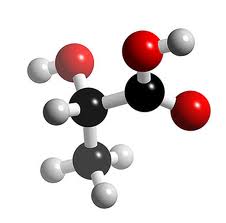Are you confused by lactate? It’s okay if you are. I sometimes am too. The problem is that researchers are constantly learning new things about the molecule, and even some of what I learned in my graduate program in exercise science in 2007-09 has already changed a bit. In reality there is enough info on lactate to write a whole book (or at least a chapter) so this will be a brief lesson in lactate. A “Lactate for Dummies” if you will!
Often you hear people complain a day or two after a hard workout that their legs hurt from lactate build up, but that’s actually not what causes the pain that far post workout. That would be DOMS- delayed onset muscle soreness, which is caused by tiny micro tears in your muscles from the exercise. Not to worry though, these micro tears are all a part of the process, because your body will repair the tears and your muscle will actually get stronger! 
So now that we’ve got that straight, let’s make this clear: its lactate, not lactic acid! Although people use the words interchangeably, there is a slight difference; namely a hydrogen atom. At physiological pH (i.e. inside your body), however, the hydrogen ion is disassociated from the lactic acid molecule, rendering it lactate. But whatever you call it, the burning in your muscles feels the same right?! Why? Well, lactate is produced in your body all the time, but production increases during exercise. Your body is actually able to utilize lactate as fuel, but only at a certain rate. The more intense your workout becomes the more lactate that is produced, and at a certain point your body can’t keep up utilization and lactate starts accumulating. This is commonly referred to as lactate threshold. And here comes the muscle burn! So when you feel that burn during exercise, it’s lactate to blame…or is it? More recently, scientists have suggested that it’s not lactate that actually causes the muscle burn during intense exercise, but instead hydrogen atom build up as a by-product of ATP utilization for energy. Researchers have also discovered that lactate can actually help this situation, because it can be formed from pyruvate (a by-product of carbohydrate breakdown for energy) combining with a free floating hydrogen and then used for fuel. So in reality, lactate is a fuel not a waste product and helpful to sports performance, not detrimental.
So why the confusion about lactate? Probably in part because of the complicated metabolic processes involved. There is a lot going on in the body during exercise, and the scientists who first discovered lactate didn’t get to see the full picture. What does all this mean for your sports performance? Well, not a whole lot. Although you can improve your lactate utilization with endurance training, if you are following some sort of program (including steady state endurance workouts, tempo runs and interval workouts), you are likely already improving your lactate utilization. So keep it up!
The bottom line is lactate is actually more friend than foe. So let’s all stop bashing lactate and give it the appreciation it deserves!
If you’d like to read more about lactate:
